阿尔及利亚Dahra地块(下Chelif盆地)最新迈西尼亚-皮亚琴阶地层系列的新认识:Lago Mare、洪水和生物事件
IF 2.6
3区 地球科学
Q2 GEOSCIENCES, MULTIDISCIPLINARY
引用次数: 0
摘要
最近在位于下切利夫盆地的Dahra地块(特别是Djebel El Abiod, Hgaf Tamda, Oued Tarhia和Sidi Brahim Telegraph)进行的地质研究揭示了后石膏矿床(messian至Piacenzian)的生物沉积事件特征。例如,在Djebel El Abiod,石膏层上方沉积了杂色粘土,随后是砂质泥灰岩和砂岩(Chara cf. hispida)的交替层,演变为(充填序列)具有pseudoatillus sp的砾岩,倾斜和断裂,其上表面受到硬地面的影响。上面是海洋绿色泥灰岩,红宝石灰色粘土演变成杂色粘土,在这个序列中没有碎屑基(侵蚀)。这一事件(变形、侵蚀)位于这些沉积层序之间,与墨西尼亚侵蚀面非常吻合。这些沉积物的古生物学内容支持了这种解释。在MES之前,第一个层序的特征是与Loxoconcha muelleri相关的一组介形虫,可以将其与Lago Mare 1生物相(Lago Mare 1事件,LM1)联系起来;第2层序以Loxocorniculina djafarovi组合为特征,与Lago Mare 2生物相(LM3)有关。其后的不整合海相沉积(SM1、SM2)标志着晚墨西尼亚期的再淹;这些砂质泥灰岩被砾岩覆盖的不整合面所封闭。本区上新世沉积始于珊瑚系白色泥灰岩(CWML)。后者之后是不整合的海相泥灰岩,间或有砂岩坝。同时,上新世发育白色泥灰岩(Trubi相),随后发育砂质泥灰岩和砂岩相间(Sidi Brahim Telegraph: SBS)。& # x0D;通过对几种生物事件的鉴定,确定了年龄:从Neopycnodonte cochlear采集的CWML中采集的gloorotalia margaritae和Reticulofenestra cisnerosii,表明较低的Zanclean年龄。灰色泥灰岩中G. puncticulata和G. cf. crotonensis的演替对应于赞尚世和皮亚琴世(Hgaf Tamda, Djebel El Abiod)。因此,位于石膏(含)和CWML之间的沉积物属于最新的墨西尼亚期。下伏的砂质泥灰岩(SM1、SM2)与最新的墨西尼亚海相回流有关,先于上新世海相沉积。这种生物事件的演替在SBS剖面上表现得很明显,该剖面是由钙质纳米浮游生物定义的迈西尼亚-上新世时期。& # x0D;CWML包括一个珊瑚结构(Cladocora cf. caespitosa和Dendrophyllia sp),其年代介于底部与gloorotalia margaritae相关的R. cisnerosii和顶部与G. puncticulata相关的disaster asymmetricus之间。它表明了一个相对温暖的事件(上新世:3 Ma),与氧同位素曲线的TG5阶段相关。本文章由计算机程序翻译,如有差异,请以英文原文为准。
New insights in the latest Messinian to Piacenzian stratigraphic series from the Dahra Massif (Lower Chelif Basin, Algeria): Lago Mare, reflooding and bio-events
Recent geological studies conducted in the Dahra Massif located in the Lower Chelif Basin (specifically, the sections of Djebel El Abiod, Hgaf Tamda, Oued Tarhia and Sidi Brahim Telegraph) revealed the bio-sedimentary events that characterize the post-gypsum deposits (Messinian to Piacenzian periods). At Djebel El Abiod, for instance, variegated clays were deposited above the gypsum layer, which were later followed by alternating layers of sandy marls and sandstones (Chara cf. hispida), evolving towards (filling sequence) conglomerates with Pseudocatillus sp, inclined and fractured, whose upper surface is affected by a hardground. Above, this are marine green marls, ruby grey clays evolving to variegated clays, a sequence from which the detrital base is absent (erosion). This event (deformation, erosion) located between these sedimentary sequences, fits well with the Messinian Erosional Surface. This interpretation is supported by the palaeontological content of these deposits. The first sequence, prior to the MES, is marked by an assemblage of Cyprideis ostracodes associated with Loxoconcha muelleri, which can be linked to Lago Mare biofacies 1 ( Lago Mare 1 event, LM1); the second sequence, characterized by the assemblage with Loxocorniculina djafarovi, is linked to Lago Mare biofacies 2 (Lago Mare 3 event, LM3). The unconformable subsequent marine sedimentation (SM1, SM2), marks the reflooding ascribed to the latest Messinian; these sandy marls are sealed by an unconformity overlain by a conglomerate. In this locality, the Pliocene sedimentation begins with coralliferous white marly limestones (CWML). Unconformable marine marls follow the latter, with intercalations of sandstone bars. Simultaneously, white marls (Trubi facies) followed by sandy marls and sandstones alternation develop during the Pliocene (Sidi Brahim Telegraph: SBS).
Ages have been established through the identification of several bioevents: Globorotalia margaritae and Reticulofenestra cisnerosii collected from the CWML with Neopycnodonte cochlear, indicating a lower Zanclean age. The succession of G. puncticulata and G. cf. crotonensis in the grey marls corresponds to the Zanclean and Piacenzian (Hgaf Tamda, Djebel El Abiod). Therefore, the deposits located between the gypsum (included) and the CWML are attributed to the latest Messinian. The underlying sandy marls (SM1, SM2) are related to the latest Messinian marine reflooding, preceding the Pliocene marine deposits. This bioevent succession is evident in the SBS section, which is of Messinian and Pliocene age defined by the calcareous nannoplankton.
The CWML includes a coral construction (Cladocora cf. caespitosa and Dendrophyllia sp), dated between the presence of R. cisnerosii associated with Globorotalia margaritae at the base and Discoaster asymmetricus associated with G. puncticulata at the top. It indicates a relatively warm event (lower Pliocene: 3 Ma) that correlates to the TG5 stage of the oxygen isotope curves.
求助全文
通过发布文献求助,成功后即可免费获取论文全文。
去求助
来源期刊
CiteScore
5.80
自引率
0.00%
发文量
18
审稿时长
>12 weeks
期刊介绍:
BSGF - Earth Sciences Bulletin publie plusieurs types de contributions :
1. des articles originaux, couvrant tous les champs disciplinaires des Géosciences, à vocation fondamentale mais également à vocation plus appliquée (risques, ressources);
2. des articles de synthèse, faisant le point sur les avancées dans un domaine spécifique des Géosciences, qu''elles soient méthodologiques ou régionales ;
3. des monographies sur la géologie d’une région donnée, assorties d’informations supplémentaires, cartes, coupes, logs, profils sismiques … publiées en ligne en annexe de l’article ;
4. des articles courts de type « express letter » ;
5. des livrets-guides d’excursion (qui suivront le même processus d’examen éditorial que les articles plus classiques) ;
6. des comptes rendus de campagnes à la mer ;
7. des articles de données géodésiques, géophysiques ou géochimiques, pouvant devenir des articles de référence pouvant conduire à des interprétations ultérieures.
BSGF - Earth Sciences Bulletin constitue également un forum pour les discussions entre spécialistes des Sciences de la Terre, de type comment-reply ou autre. Tous les articles publiés, quelle que soit leur forme, seront accessibles sans frais (articles en Open Access) sur le site de la SGF et sur celui de Geosciences World dans la mesure où les auteurs se seront acquittés d’une contribution de (Article Processing Charges – APC) de 300€ pour les membres de la SGF et 500€ pour les non-membres.

 求助内容:
求助内容: 应助结果提醒方式:
应助结果提醒方式:


